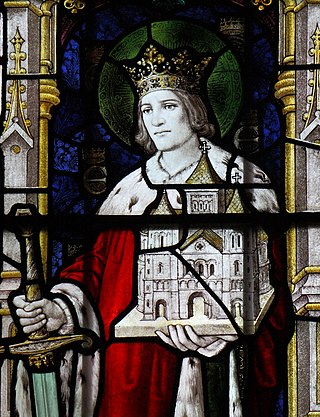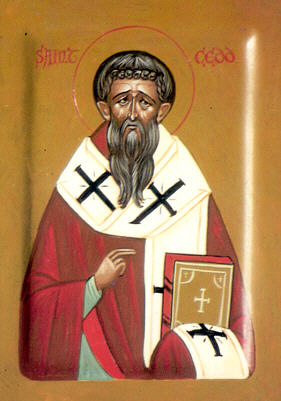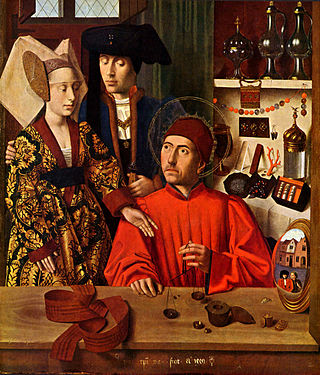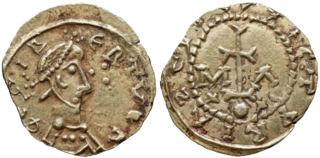See also
Name list
This page or section lists people that share the same given name. If an internal link led you here, you may wish to change that link to point directly to the intended article.
Sigebert (which means roughly "magnificent victory"), also spelled Sigibert, Sigobert, Sigeberht, or Siegeberht, is the name of:

The Kingdom of the East Saxons, referred to as the Kingdom of Essex, was one of the seven traditional kingdoms of the Anglo-Saxon Heptarchy. It was founded in the 6th century and covered the territory later occupied by the counties of Essex, Middlesex, much of Hertfordshire and west Kent. The last king of Essex was Sigered of Essex, who in 825 ceded the kingdom to Ecgberht, King of Wessex.
The 610s decade ran from January 1, 610, to December 31, 619.
The 650s decade ran from January 1, 650, to December 31, 659.

Year 630 (DCXXX) was a common year starting on Monday of the Julian calendar. The denomination 630 for this year has been used since the early medieval period, when the Anno Domini calendar era became the prevalent method in Europe for naming years.

Year 616 (DCXVI) was a leap year starting on Thursday of the Julian calendar. The denomination 616 for this year has been used since the early medieval period, when the Anno Domini calendar era became the prevalent method in Europe for naming years.

Year 653 (DCLIII) was a common year starting on Tuesday of the Julian calendar. The denomination 653 for this year has been used since the early medieval period, when the Anno Domini calendar era became the prevalent method in Europe for naming years.

Year 660 (DCLX) was a leap year starting on Wednesday of the Julian calendar. The denomination 660 for this year has been used since the early medieval period, when the Anno Domini calendar era became the prevalent method in Europe for naming years.

Austrasia was a territory which formed the north-eastern section of the Merovingian Kingdom of the Franks during the 6th to 8th centuries. It was centred on the Meuse, Middle Rhine and the Moselle rivers, and was the original territory of the Franks, including both the so-called Salians and Rhineland Franks, which Clovis I conquered after first taking control of the bordering part of Roman Gaul, now northern France, which is sometimes described in this period as Neustria.
Æthelhere was King of East Anglia from 653 or 654 until his death. He was a member of the ruling Wuffingas dynasty and one of three sons of Eni to rule East Anglia as Christian kings. He was a nephew of Rædwald, who was the first of the Wuffingas of which more than a name is known.

Sigebert III was the Merovingian king of Austrasia from 633 to his death around 656. He was described as the first Merovingian roi fainéant —do-nothing king—, in effect the mayor of the palace ruling the kingdom throughout his reign. However he lived a pious Christian life and was later sanctified, being remembered as Saint Sigebert of Austrasia in the Roman Catholic Church and Eastern Orthodox Church.

Sigebert II (601–613) or Sigisbert II, was the illegitimate son of Theuderic II, from whom he inherited the kingdoms of Burgundy and Austrasia in 613. However, he fell under the influence of his great-grandmother, Brunhilda. Warnachar, mayor of the palace of Austrasia had Sigebert brought before a national assembly, where he was proclaimed king by the nobles over both his father's kingdoms. However, when the kingdom was invaded by Clotaire II of Neustria, Warnachar and Rado, mayor of the palace of Burgundy, betrayed Sigebert and Brunhilda and joined with Clotaire, recognising Clotaire as rightful regent and guardian of Sigebert and ordering the army not to oppose the Neustrians. Brunhilda and Sigebert met Clotaire's army on the Aisne, but the Patrician Aletheus, Duke Rocco, and Duke Sigvald deserted her host and Brunhilda and Sigebert were forced to flee, before being taken by Clotaire's men at Lake Neuchâtel. Brunhilda, little Sigebert and Sigebert's younger brother Corbo were executed by Clotaire's orders, and Austrasia and Neustria were reunited under Clotaire's rule, who now ruled the entire kingdom of the Franks.
Sexred, or Sexræd, was a king of the East Saxons.
Sigeberht the Little was king of Essex from 623? to 653. A Sigeberht was the son of Sæward, who was slain in battle against forces from Wessex in 623(?), and father of later king Sighere, but Yorke thought it more likely this was his successor, Sigeberht the Good. Sigeberht the Little was considered a pagan and most likely allied with Penda of Mercia in 635, who was also a pagan.
Sigeberht of East Anglia, was a saint and a king of East Anglia, the Anglo-Saxon kingdom which today includes the English counties of Norfolk and Suffolk. He was the first English king to receive a Christian baptism and education before his succession and the first to abdicate in order to enter the monastic life. The principal source for Sigeberht is Bede's Ecclesiastical History of the English People, which was completed in the 730s.
Æthelwold, also known as Æthelwald or Æþelwald, was a 7th-century king of East Anglia, the long-lived Anglo-Saxon kingdom which today includes the English counties of Norfolk and Suffolk. He was a member of the Wuffingas dynasty, which ruled East Anglia from their regio at Rendlesham. The two Anglo-Saxon cemeteries at Sutton Hoo, the monastery at Iken, the East Anglian see at Dommoc and the emerging port of Ipswich were all in the vicinity of Rendlesham.
Saint Beuve and her brother Balderic lived in the 7th century in France. According to Christian Settipani, their father was probably Sigobert the Lame, King of Cologne, rather than Sigebert I of Austrasia, as indicated by Flodoard. Together they founded the Abbey of Saint Pierre de Reims. Beuve was the first abbess.
Saint Dode was an Abbess of Saint Pierre de Reims and a French Saint whose Feast Day is 24 April. She is reputed to be the daughter of Chloderic, King of the Ripuarian Franks and the sister of Munderic, making her a princess of the Ripuarian Franks.
Events from the 7th century in England.
The Christianisation of Anglo-Saxon England was a process spanning the 7th century. It was essentially the result of the Gregorian mission of 597, which was joined by the efforts of the Hiberno-Scottish mission from the 630s. From the 8th century, the Anglo-Saxon mission was, in turn, instrumental in the conversion of the population of the Frankish Empire.